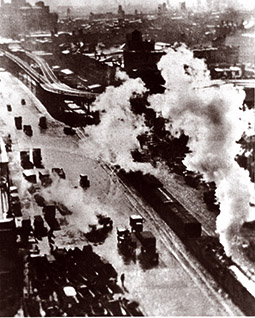|
When the Pennsylvania Railroad purchased the Philadelphia Navy Yard headquarters at Delaware Avenue and Washington Avenue in January, 1876, they expanded Pier 53 into a fully functioning immigration pier. By 1896, moderization of the immigration station was able to handle 300 English-speaking or 150 non-English speaking immigrants per hour, or up to 1,500 per day. Before the improvements, the maximum was 300 per day. Contemporary photos show railroad tracks running from inside the newly constructed building and a tangle of tracks along Delaware Avenue. The railroad provided a means of transport inland for newly arriving steamship passengers. Many people arrived in Philadelphia to stay only briefly, heading north, south, and west; those who could not afford train fare settled in the neighborhoods near the waterfront. In many cases the steamship lines that transported the immigrants offered them jobs when they arrived, or found them jobs before letting them land.
First came the Swedes, the Scots-Irish, the English, and the Germans. Later the Irish (especially after the potato famine in 1847-1848); In the latter part of the 19th century came the Italians, the Poles, the Ukranians, Russians, Lithuanians; in the early 20th century came the Russian and Polish Jews, fleeing pogroms in Europe. |
The South Philadelphia neighborhoods were crowded. In 1910 the Third Ward (Fitzwater to Christian, Broad Street east to the Delaware River — part of what is now known as Southwark) had a density of 130,000 people per square mile. Clues to the identities of early South Philadelphia inhabitants can be found in the churches and synagogues, some of which are still standing. A Lithuanian church may be within a block of a German church and an Irish church. All of the congregants were Catholic, but the churches were named for a Lithuanian saint, A German saint, and an Irish saint. The homilies at the Masses were respectively in Lithuanian, in German, and in English. Jews from eastern Europe who fled the pogroms in the early twentieth century found solace and community in Philadelphia. Orthodox congregations clustered around synagogues in the 'Jewish Quarter' in South Philadelphia. Unlike the synagoges in Europe, many in the city were small—some the size of a single row house. New arrivals would identify with a rabbi and a specific congregation, just as Christians would identify with a specific parish. Newly-arriving ethnic groups tended to cluster in the same neighborhoods, at least for the first generation. For example, Italians still have a concentrated presence around Ninth Street (the “Italian Market”) although today this is rapidly changing to an ethnic Mexican and Asian neighborhood.
| The Irish families who were the first arrivals stayed in the waterfront neighborhoods and were among the first to branch out geographically to other parts of the city. The City of Philadelphia at the turn of the twentieth century had a much greater land area than any of the other immigrant-heavy citizens like Boston or Manhattan. Land prices were lower and population could become more easily dispersed. Cheap, available land made possible low-density neighborhoods; ordinary working-class families were able to own a two-story brick house. There were many unskilled and semi-skilled jobs available — jobs on the docks along the river, mills, factories. Many first generation immigrants became domestics in homes of a burgeoning upper-middle-class population who lived nearer to the city center. There was plenty of work in local sugar refineries along the river. The Pier 53 Project. This is a joint venture between the Friends of Washington Avenue Green and the Delaware River Waterfront Corporation (DRWC). The aim is to collect information from people who believe their ancestors may have come in to America through Pier 53. After the "immigration list" is compiled, research will begin at the Historical Society of Philadelphia to determine precise information of the ship, the year, and the steamship line of each person on the list. From there, participants will be asked to fill in a more detailed family history of their ancestors to help solidify the neighborhood connection to the pier. Conjuring Ghosts. The Metro Section of the February 1 Philadelphia Inquirer did a feature story on Susan McAninley and her work collecting stories of immigrants coming to Philadelphia through Pier 53. Here's the link. Looking to participate in the Pier 53 Project? Click this link: Pier53project@washingtonavenuegreen.com or visit our Facebook page. http://www.facebook.com/WashingtonAveGreen. Participants, descendants, and volunteers are needed. Top art is a composite of an 1883 passenger list and an illustration of the pediment of the Immigration Station.
|

